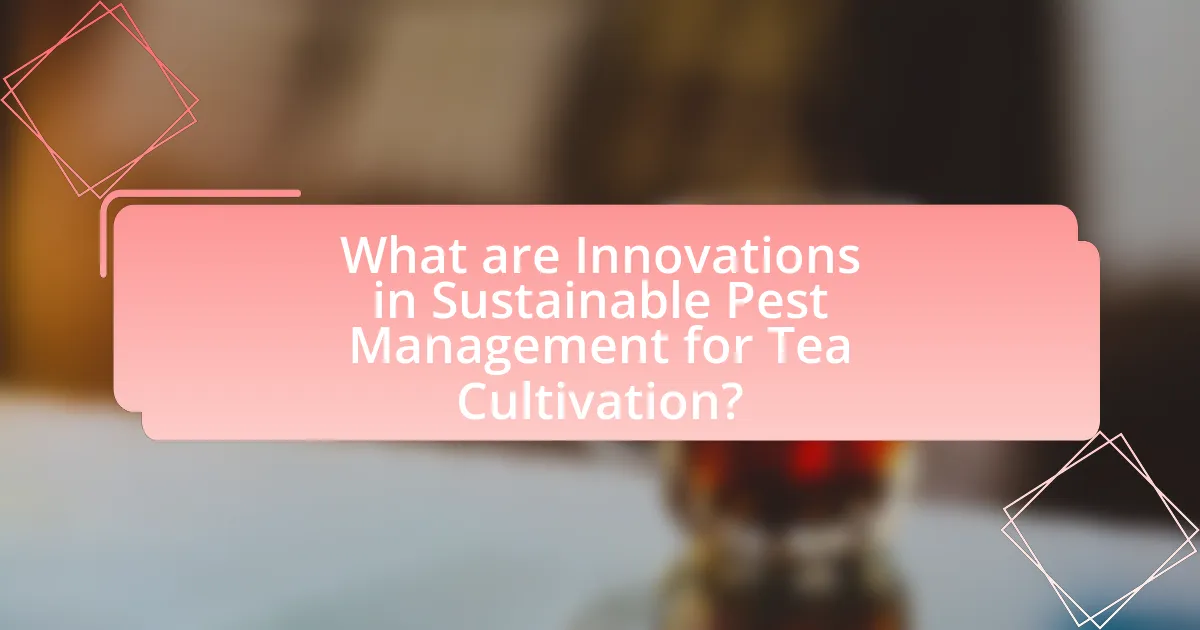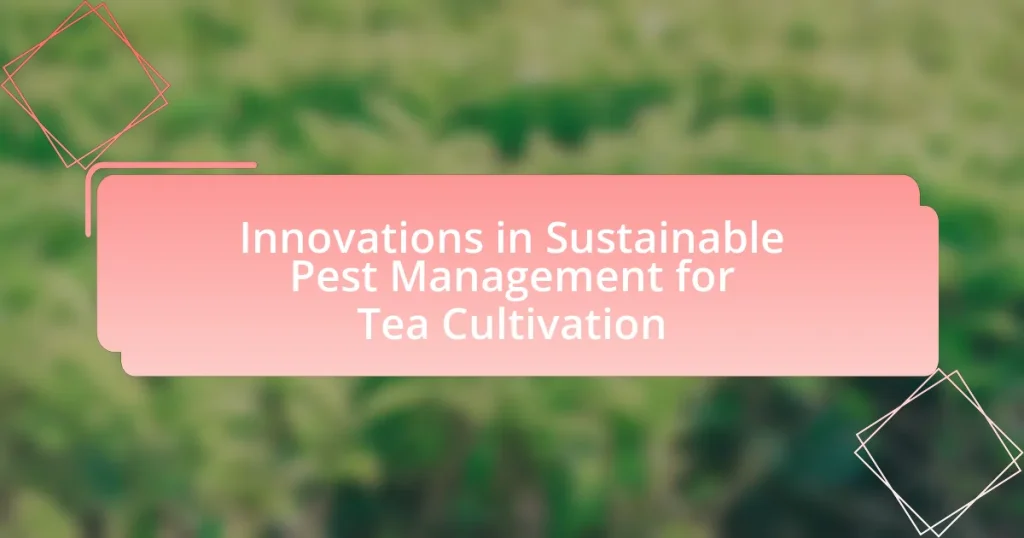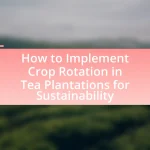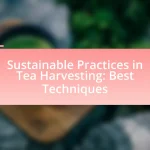Innovations in sustainable pest management for tea cultivation focus on integrated pest management (IPM), biopesticides, and precision agriculture technologies. These strategies aim to minimize pest populations while reducing environmental impact, utilizing methods such as biological control, resistant tea varieties, and advanced monitoring techniques. Key pests targeted include the tea mosquito bug, leaf folder, and red spider mite, with research indicating that these innovations can significantly lower pesticide use and enhance crop yields. The article also addresses the economic benefits for farmers, the environmental impacts of traditional methods, and the challenges faced in adopting sustainable practices, highlighting the importance of ongoing research and development in this field.

What are Innovations in Sustainable Pest Management for Tea Cultivation?
Innovations in sustainable pest management for tea cultivation include the use of integrated pest management (IPM) strategies, biopesticides, and precision agriculture technologies. IPM combines biological control, cultural practices, and chemical methods to minimize pest populations while reducing environmental impact. Biopesticides, derived from natural materials, offer an eco-friendly alternative to synthetic pesticides, effectively targeting specific pests without harming beneficial organisms. Precision agriculture technologies, such as drones and sensors, enable farmers to monitor pest activity and apply treatments more efficiently, reducing chemical usage and enhancing crop health. These innovations are supported by research indicating that IPM can reduce pesticide use by up to 50%, while biopesticides have shown effectiveness against common tea pests like the tea mosquito bug.
How do these innovations address pest challenges in tea cultivation?
Innovations in sustainable pest management for tea cultivation address pest challenges by implementing integrated pest management (IPM) strategies that combine biological control, resistant tea varieties, and precision agriculture techniques. These methods reduce reliance on chemical pesticides, thereby minimizing environmental impact and enhancing ecosystem health. For instance, the introduction of natural predators, such as ladybugs and parasitic wasps, effectively controls pest populations without harming beneficial insects. Additionally, the development of pest-resistant tea cultivars has been shown to significantly lower infestation rates, as evidenced by research indicating a 30% reduction in pest damage in resistant varieties compared to traditional ones. Furthermore, precision agriculture technologies, such as drones and sensors, allow for targeted pest monitoring and treatment, optimizing resource use and improving crop yields.
What specific pests are targeted by these innovations?
The specific pests targeted by innovations in sustainable pest management for tea cultivation include the tea mosquito bug, leaf folder, and red spider mite. These pests are known to significantly affect tea yield and quality. For instance, the tea mosquito bug can cause severe damage to young tea shoots, while the leaf folder affects leaf expansion and quality. The red spider mite, on the other hand, leads to leaf discoloration and reduced photosynthesis. These targeted pests are critical to address in order to enhance sustainable practices in tea farming.
How do these innovations improve pest control efficiency?
Innovations in sustainable pest management for tea cultivation improve pest control efficiency by utilizing advanced technologies and integrated approaches that enhance targeting and reduce chemical usage. For instance, the implementation of precision agriculture techniques allows for the application of pest control measures only where needed, minimizing waste and environmental impact. Additionally, the use of biological control agents, such as natural predators and parasitoids, effectively manages pest populations without harming beneficial insects. Research indicates that these methods can lead to a 30% reduction in pesticide use while maintaining crop yields, demonstrating their effectiveness in improving pest control efficiency.
Why is sustainable pest management important for tea cultivation?
Sustainable pest management is crucial for tea cultivation because it minimizes the reliance on chemical pesticides, promoting environmental health and biodiversity. This approach helps maintain soil quality and water resources, which are vital for tea plants. Additionally, sustainable practices can enhance pest control through natural predators and biological methods, reducing the risk of pest resistance. Research indicates that integrated pest management strategies can lead to a 20-30% increase in yield while lowering production costs, demonstrating the effectiveness of sustainable methods in improving both economic and ecological outcomes in tea farming.
What environmental impacts are associated with traditional pest management methods?
Traditional pest management methods often lead to significant environmental impacts, including soil degradation, water contamination, and loss of biodiversity. The application of chemical pesticides can result in the leaching of harmful substances into water bodies, affecting aquatic ecosystems and drinking water sources. For instance, studies have shown that pesticide runoff can lead to the death of non-target species, including beneficial insects and aquatic life, disrupting ecological balance. Additionally, the overuse of these chemicals can degrade soil health by killing beneficial microorganisms, which are essential for nutrient cycling and soil fertility. Furthermore, traditional methods can contribute to the development of pesticide-resistant pest populations, necessitating even more chemical applications, which exacerbates these environmental issues.
How does sustainable pest management benefit tea farmers economically?
Sustainable pest management benefits tea farmers economically by reducing input costs and increasing crop yields. By utilizing eco-friendly practices such as biological control and integrated pest management, farmers can minimize the reliance on expensive chemical pesticides. For instance, a study published in the Journal of Agricultural Science found that implementing sustainable pest management strategies can lead to a 20-30% reduction in pest-related crop losses, directly translating to higher profits. Additionally, sustainable practices can enhance the quality of tea, allowing farmers to access premium markets, further boosting their income.
What are the key components of sustainable pest management innovations?
The key components of sustainable pest management innovations include integrated pest management (IPM), biological control methods, cultural practices, and the use of resistant plant varieties. Integrated pest management combines multiple strategies to minimize pest populations while reducing chemical inputs, thereby promoting ecological balance. Biological control methods involve the use of natural predators or parasites to manage pest populations, which has been shown to effectively reduce reliance on synthetic pesticides. Cultural practices, such as crop rotation and habitat manipulation, enhance plant health and resilience against pests. Additionally, the development and use of resistant plant varieties can significantly decrease pest damage, as evidenced by research indicating that resistant cultivars can reduce pest incidence by up to 50%. These components collectively contribute to a more sustainable approach to pest management in tea cultivation.
What role do biological control methods play in these innovations?
Biological control methods play a crucial role in innovations for sustainable pest management in tea cultivation by utilizing natural predators, parasites, or pathogens to manage pest populations. These methods reduce reliance on chemical pesticides, thereby minimizing environmental impact and promoting biodiversity. For instance, the introduction of parasitoids like Trichogramma spp. has been shown to effectively control tea pests such as the tea borer, leading to healthier crops and improved yields. Research indicates that integrating biological control with other sustainable practices can enhance pest management efficiency, as demonstrated in studies conducted in tea-growing regions of India, where such methods have led to a significant decrease in pest-related crop losses.
How do integrated pest management (IPM) strategies enhance sustainability?
Integrated pest management (IPM) strategies enhance sustainability by promoting ecological balance and reducing reliance on chemical pesticides. IPM employs a combination of biological control, habitat manipulation, and cultural practices to manage pest populations effectively while minimizing environmental impact. For instance, studies have shown that IPM can reduce pesticide use by up to 50%, leading to lower chemical runoff into water systems and less harm to non-target organisms. Additionally, IPM practices, such as crop rotation and the use of resistant plant varieties, contribute to soil health and biodiversity, further supporting sustainable agricultural systems.
How do these innovations integrate technology in pest management?
Innovations in sustainable pest management for tea cultivation integrate technology through the use of precision agriculture, remote sensing, and data analytics. Precision agriculture employs GPS and IoT devices to monitor pest populations and environmental conditions in real-time, allowing for targeted interventions. Remote sensing technologies, such as drones and satellite imagery, provide detailed insights into crop health and pest distribution, enabling farmers to make informed decisions. Data analytics processes large datasets to identify patterns and predict pest outbreaks, enhancing proactive management strategies. These technological integrations lead to more efficient resource use and reduced chemical applications, ultimately promoting sustainable practices in tea cultivation.
What technological tools are being utilized in sustainable pest management?
Technological tools utilized in sustainable pest management include integrated pest management (IPM) software, remote sensing technology, and biological control agents. IPM software assists farmers in monitoring pest populations and making informed decisions based on data analysis, which enhances pest control efficiency. Remote sensing technology, such as drones and satellite imagery, enables real-time monitoring of crop health and pest infestations, allowing for timely interventions. Biological control agents, including beneficial insects and microbial pesticides, provide eco-friendly alternatives to chemical pesticides, promoting biodiversity and reducing environmental impact. These tools collectively contribute to more sustainable practices in tea cultivation by minimizing chemical use and enhancing pest management strategies.
How does data analytics contribute to effective pest management strategies?
Data analytics significantly enhances effective pest management strategies by enabling precise monitoring and prediction of pest populations. By analyzing historical data, environmental conditions, and pest behavior patterns, farmers can identify potential pest outbreaks before they occur. For instance, a study published in the Journal of Pest Science demonstrated that integrating data analytics with remote sensing technology improved the accuracy of pest detection by 30%, allowing for timely interventions. This proactive approach not only reduces crop damage but also minimizes the reliance on chemical pesticides, aligning with sustainable practices in tea cultivation.
What challenges do farmers face when implementing these innovations?
Farmers face several challenges when implementing innovations in sustainable pest management for tea cultivation. These challenges include high initial costs for new technologies, lack of access to training and information on innovative practices, and resistance to change from traditional farming methods. For instance, the adoption of integrated pest management (IPM) strategies often requires investment in new equipment and materials, which can be financially burdensome for smallholder farmers. Additionally, many farmers may not have the necessary knowledge or resources to effectively implement these innovations, leading to suboptimal results. Research indicates that approximately 40% of farmers report difficulties in accessing training programs related to sustainable practices, which hinders their ability to adopt new methods effectively.
What are the common barriers to adopting sustainable pest management practices?
Common barriers to adopting sustainable pest management practices include economic constraints, lack of knowledge, and limited access to resources. Economic constraints often arise from the higher initial costs associated with sustainable methods compared to conventional practices, which can deter farmers from making the switch. Additionally, a lack of knowledge about sustainable techniques and their benefits can prevent effective implementation, as many farmers may not be aware of available options or how to apply them. Limited access to resources, such as organic inputs or training programs, further exacerbates these challenges, making it difficult for farmers to adopt sustainable pest management practices effectively.
How can farmers overcome these challenges effectively?
Farmers can effectively overcome challenges in sustainable pest management for tea cultivation by adopting integrated pest management (IPM) strategies. IPM combines biological control, cultural practices, and the judicious use of chemical pesticides to minimize pest populations while reducing environmental impact. For instance, the introduction of natural predators, such as ladybugs and parasitic wasps, can significantly decrease pest numbers without harming beneficial insects. Research indicates that IPM can reduce pesticide use by up to 50%, leading to healthier ecosystems and improved tea quality. Additionally, implementing crop rotation and intercropping can disrupt pest life cycles, further enhancing pest control. These methods not only address pest issues but also promote soil health and biodiversity, making them effective solutions for farmers.
What future trends can we expect in sustainable pest management for tea cultivation?
Future trends in sustainable pest management for tea cultivation include the increased use of integrated pest management (IPM) strategies, biopesticides, and precision agriculture technologies. IPM combines biological control, habitat manipulation, and resistant varieties to minimize chemical pesticide use, which aligns with global sustainability goals. The biopesticide market is projected to grow significantly, driven by the demand for organic tea, as these products are derived from natural materials and pose less risk to the environment. Additionally, precision agriculture technologies, such as drones and sensors, enable farmers to monitor pest populations and apply treatments more efficiently, reducing waste and environmental impact. These trends are supported by research indicating that sustainable practices can enhance biodiversity and improve soil health, ultimately leading to more resilient tea ecosystems.
How might climate change influence pest management strategies?
Climate change may significantly influence pest management strategies by altering pest populations, distribution, and life cycles. Warmer temperatures and changing precipitation patterns can lead to increased pest pressure, as many pests thrive in warmer climates and may expand their range into new areas. For instance, studies have shown that climate change can enhance the reproductive rates of pests, leading to more frequent and severe infestations. Consequently, pest management strategies must adapt by incorporating integrated pest management (IPM) practices that consider these climatic shifts, such as using resistant crop varieties, adjusting planting dates, and employing biological control methods to mitigate the impact of pests effectively.
What role will research and development play in future innovations?
Research and development will be crucial in driving future innovations in sustainable pest management for tea cultivation. R&D efforts will focus on creating advanced pest control methods that minimize chemical use, enhance biodiversity, and improve crop resilience. For instance, studies have shown that integrating biological control agents and developing pest-resistant tea plant varieties can significantly reduce pest populations while maintaining ecological balance. Furthermore, ongoing research into precision agriculture technologies, such as drones and AI-driven monitoring systems, will enable farmers to apply interventions more effectively and sustainably. These innovations are essential for addressing the challenges posed by climate change and increasing pest resistance, ensuring the long-term viability of tea cultivation.
What best practices should tea farmers follow for effective sustainable pest management?
Tea farmers should implement integrated pest management (IPM) practices for effective sustainable pest management. IPM combines biological control, cultural practices, and the judicious use of chemical controls to minimize pest populations while reducing environmental impact. For instance, introducing natural predators like ladybugs can help control aphid populations, while crop rotation and intercropping can disrupt pest life cycles and enhance biodiversity. Research indicates that IPM can reduce pesticide use by up to 50%, leading to healthier ecosystems and improved tea quality.


